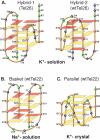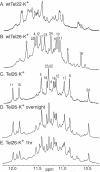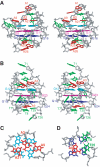Polymorphism of human telomeric quadruplex structures
- PMID: 18373984
- PMCID: PMC2556180
- DOI: 10.1016/j.biochi.2008.02.026
Polymorphism of human telomeric quadruplex structures
Abstract
Human telomeric DNA consists of tandem repeats of the sequence d(TTAGGG). Compounds that can stabilize the intramolecular DNA G-quadruplexes formed in the human telomeric sequence have been shown to inhibit the activity of telomerase and telomere maintenance, thus the telomeric DNA G-quadruplex has been considered as an attractive target for cancer therapeutic intervention. Knowledge of intramolecular human telomeric G-quadruplex structure(s) formed under physiological conditions is important for structure-based rational drug design and thus has been the subject of intense investigation. This review will give an overview of recent progress on the intramolecular human telomeric G-quadruplex structures formed in K+ solution. It will also give insight into the structure polymorphism of human telomeric sequences and its implications for drug targeting.
Figures









Similar articles
-
Human telomeric sequence forms a hybrid-type intramolecular G-quadruplex structure with mixed parallel/antiparallel strands in potassium solution.Nucleic Acids Res. 2006 May 19;34(9):2723-35. doi: 10.1093/nar/gkl348. Print 2006. Nucleic Acids Res. 2006. PMID: 16714449 Free PMC article.
-
Structure of the Hybrid-2 type intramolecular human telomeric G-quadruplex in K+ solution: insights into structure polymorphism of the human telomeric sequence.Nucleic Acids Res. 2007;35(15):4927-40. doi: 10.1093/nar/gkm522. Epub 2007 Jul 10. Nucleic Acids Res. 2007. PMID: 17626043 Free PMC article.
-
Structure of a two-G-tetrad intramolecular G-quadruplex formed by a variant human telomeric sequence in K+ solution: insights into the interconversion of human telomeric G-quadruplex structures.Nucleic Acids Res. 2010 Jan;38(3):1009-21. doi: 10.1093/nar/gkp1029. Epub 2009 Nov 27. Nucleic Acids Res. 2010. PMID: 19946019 Free PMC article.
-
Recent advances in targeting the telomeric G-quadruplex DNA sequence with small molecules as a strategy for anticancer therapies.Future Med Chem. 2016 Jul;8(11):1259-90. doi: 10.4155/fmc-2015-0017. Epub 2016 Jul 21. Future Med Chem. 2016. PMID: 27442231 Review.
-
Structure, Topology, and Stability of Multiple G-quadruplexes in Long Telomeric Overhangs.J Mol Biol. 2024 Jan 1;436(1):168205. doi: 10.1016/j.jmb.2023.168205. Epub 2023 Jul 20. J Mol Biol. 2024. PMID: 37481156 Free PMC article. Review.
Cited by
-
DNA G-quadruplex and its potential as anticancer drug target.Sci China Chem. 2014 Dec;57(12):1605-1614. doi: 10.1007/s11426-014-5235-3. Epub 2014 Nov 15. Sci China Chem. 2014. PMID: 27182219 Free PMC article.
-
Distinct differences in metal ion specificity of RNA and DNA G-quadruplexes.J Biol Inorg Chem. 2016 Dec;21(8):975-986. doi: 10.1007/s00775-016-1393-4. Epub 2016 Oct 4. J Biol Inorg Chem. 2016. PMID: 27704222
-
How long is too long? Effects of loop size on G-quadruplex stability.Nucleic Acids Res. 2010 Nov;38(21):7858-68. doi: 10.1093/nar/gkq639. Epub 2010 Jul 26. Nucleic Acids Res. 2010. PMID: 20660477 Free PMC article.
-
Structure of a 28.5 kDa duplex-embedded G-quadruplex system resolved to 7.4 Å resolution with cryo-EM.Nucleic Acids Res. 2023 Feb 28;51(4):1943-1959. doi: 10.1093/nar/gkad014. Nucleic Acids Res. 2023. PMID: 36715343 Free PMC article.
-
Structural dynamics of propeller loop: towards folding of RNA G-quadruplex.Nucleic Acids Res. 2018 Sep 28;46(17):8754-8771. doi: 10.1093/nar/gky712. Nucleic Acids Res. 2018. PMID: 30165550 Free PMC article.
References
-
- Blackburn EH. Telomere states and cell fates. Nature. 2000;408:53–56. - PubMed
-
- van Steensel B, Smogorzewska A, de Lange T. TRF2 protects human telomeres from end-to-end fusions. Cell. 1998;92:401–413. - PubMed
-
- Hackett JA, Feldser DM, Greider CW. Telomere dysfunction increases mutation rate and genomic instability. Cell. 2001;106:275–286. - PubMed
-
- Blackburn EH, Gall JG. A tandemly repeated sequence at the termini of extrachromosomal ribosomal RNA genes in Tetrahymena. J. Mol. Biol. 1978;120:33–53. - PubMed
Publication types
MeSH terms
Substances
Grants and funding
LinkOut - more resources
Full Text Sources
Other Literature Sources

